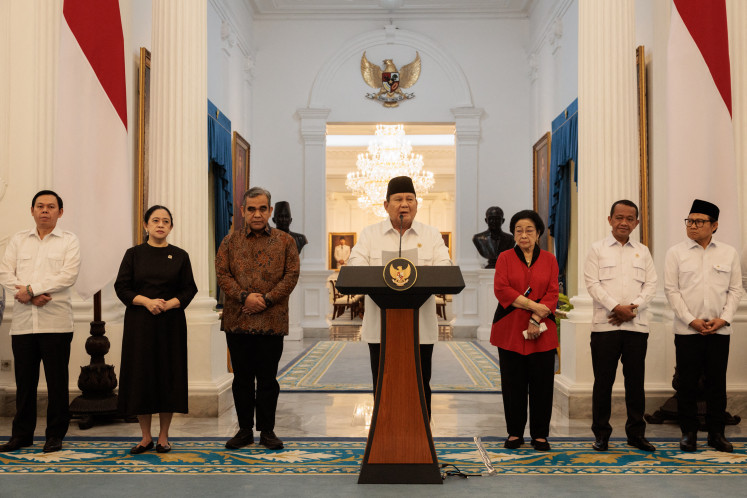Popular Reads
Top Results
Can't find what you're looking for?
View all search resultsPopular Reads
Top Results
Can't find what you're looking for?
View all search resultsFighting corruption globally through digitalization
Our research shows that over the first 12 years of designing, building and maintaining an e-procurement system, costs will average $16.7 million, irrespective of a country’s size—a relatively trivial sum compared to most government budgets.
Change text size
Gift Premium Articles
to Anyone
W
hen the COVID-19 pandemic struck, all of the world needed to urgently buy protective gear, oxygen and ventilators. The countries that moved fastest and made the best spending decisions had electronic procurement systems in place. These systems not only help in crisis, but are crucial for reducing corruption and saving governments billions of dollars.
How governments spend money is something most of us seldom consider. Yet this money adds up to a fortune. Governments are by far the largest buyers of works, goods, and services from the private sector. Public procurement amounted to US$11 trillion in 2019. That’s around 12 percent of global gross domestic product. In the countries where the poorer half of the world’s population lives, procurement makes up an astounding half of all government expenditure.
Electronic procurement or “e-procurement” speeds up this important spending, and speed is crucial in crises like COVID-19. In South Korea, introducing e-procurement meant the duration of the processing of bids was cut from an average of 30 hours to just 2 hours, whereas in Argentina the duration of the public procurement process fell by more than 11 days.
But e-procurement does far more than just let governments move more quickly. It makes government spending less corrupt and more effective. This is crucial, because corruption is a trillion-dollar problem globally each year, with very few answers. The world is doing just as poorly now on corruption as it was a decade ago, according to Transparency International.
My think-tank, the Copenhagen Consensus Center, has identified e-procurement as a crucial policy for the four-in-ten low-income governments that still haven’t implemented it. This research is part of our multi-year project working with dozens of the world’s leading economists to identify the global best policies to speed up achievement of the Sustainable Development Goals (SDGs).
These goals run from 2016 to 2030, so this year we are at halftime—yet we are failing on nearly every single one of them. And on the SDG target of eliminating corruption, we are making zero progress at all.
Public procurement, because of its size, is one of the biggest corruption sources for every country, so introducing e-procurement can be an incredibly effective way to tackle corruption. Moreover, it can actually also end up making countries billions richer.
Our research shows that over the first 12 years of designing, building and maintaining an e-procurement system, costs will average $16.7 million, irrespective of a country’s size—a relatively trivial sum compared to most government budgets.
There are many benefits, as was shown during the COVID-19 pandemic. E-procurement not only speeds the ability of governments to act; it also increases the number of bidders. India’s Karnataka State found the number of suppliers increased from 130 to 4,800 in the first three years of e-procurement, while South Korea saw the number of bidders double from 70,000 to 147,000 in the same period.
And having transparent, widely accessible systems means governments can spend less advertising for bids. The Indian state of Andhra Pradesh found it could save half a million dollars annually on advertising, while the Philippine government saved $9 million annually on newspaper advertisements.
There is also evidence that digitizing procurement means better oversight and improved service delivery. A good example is India, where there was a 12 percent increase in road quality grade after shifting to an e-procurement system. Reforms in Paraguay reduced the percentage of contracting processes that needed amending, from 19 percent in 2013 to just 3 percent in 2016.
The most obvious, immediate, and well-documented consequence is that e-procurement simply saves the government money. Our research shows the average cost-cutting across all procurement is 6.75 percent.
For the average low-income country, this means the benefits across the first 12 years amount to more than $600 million. For each dollar spent, the low-income country will realize savings worth $38. For lower-middle-income countries, the average benefits are more than $5 billion over the first 12 years, meaning each dollar spent creates more than $300 of social benefits. This makes e-procurement an exceptionally effective policy.
And it is not just in times of a pandemic like COVID-19 that an e-procurement system can show its worth. Having an e-procurement system helped Ukraine’s government to continue to function when it was invaded by Russia. Transparency International reported in March 2022 that “the procurement system and all platforms continue to operate” every single day, even as much of the country was under attack.
As many countries face new threats in the future that may require large-scale spending in short periods, e-procurement can allow governments to do so more quickly and more efficiently—and with far less corruption. Introducing an e-procurement system is not only a proven way to cut waste and graft in public spending but also to build resilience and be much better prepared for the challenges ahead.
It’s a phenomenal policy that every country should pursue.
***
The writer is president of the Copenhagen Consensus, a visiting fellow at Stanford University's Hoover Institution, and the author, most recently, of Best Things First.











